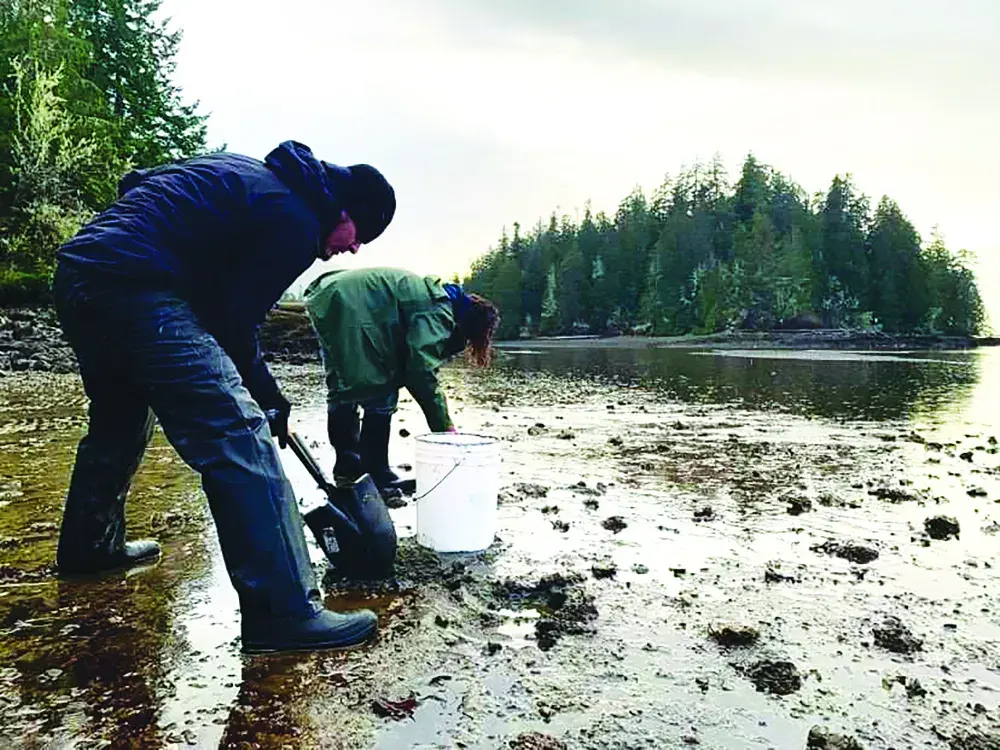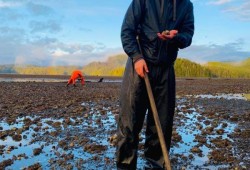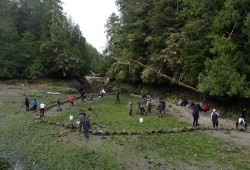In late Spring, $80,000 was allocated to the Nuu-chah-nulth Youth Warrior Family Society with Ka:’yu:’k’t’h/Che:k’tles7et’h to support food security and the development of clam gardens throughout Nuu-chah-nulth territory. Since then, youth from across Nuu-chah-nulth have restored two clam gardens located in Tla-o-qui-aht and Huu-ay-aht territory with plans for more to come.
Hayden Seitcher of the Tla-o-qui-aht Youth Warriors told Ha-Shilth-Sa that the process to build clam gardens began when Gisele Martin, also of Tla-o-qui-aht, proposed to the youth that they “restore and bring back clam gardens.”
According to the Clam Gardens Network, these sites are a prehistoric practice used by Indigenous people to increase the production of culturally significant seafood across Washington, B.C., and Alaska, with “hundreds, if not thousands” yet to be recorded.
Clam Gardens Network indicates that modified beaches have 150 to 300 per cent more clam production than unmodified beaches as well as double to quadruple the biomass.
Youth, community members, and elders have come together to share knowledge and methodically move rocks throughout the intertidal zones of Sarita Bay in Huu-ay-aht territory and Meares Island in Tla-o-qui-aht territory to create clam gardens that can be utilized by their nations.
“Following lowest tide, you'll be putting rocks along a wall,” said Seitcher when explaining what building a clam garden entails. “You’re creating almost like a filter for sediment to come in.”
Once sediment collects along the rock wall, a shallow sloped terrace forms creating the ideal intertidal conditions for clams to grow and spawn, according to Clam Gardens Network.
“And you’re clearing the rocks from inside that wall to create space for the clams to go in,” said Seitcher. “You’re making space for them to breathe.”
“The walls are meant to catch the eggs as well as sediment,” added Seitcher.
Daniel Blackstone assisted with the Tla-o-qui-aht clam garden along with two Ka:’yu:’k’t’h/Che:k’tles7et’h youth warriors. He said that the very next day he had the opportunity to revisit the site and found butter clams along the beach, which Blackstone said indicates spawning among the clams.
“Some of the stories have to do with recognizing that the clams populate in a given space laterally along the shore, which indicates that there's a preferred height of the beach that they would prefer to spawn in,” said Blackstone. “What they do when they build a rock wall is they broaden that spawning ground, they make it much wider and much higher.”
Blackstone added that over time by continuing to add rocks to the wall, the bed of the beach will raise to the ideal level to increase clam productivity.
“A lot of caretaking ways that have been in place over thousands of years have been heavily distributed by colonialism,” said Martin. “There are many sites where there used to be clam gardens, some of them have been totally destroyed.”
Martin added that the intertidal zone along Tofino’s downtown waterfront was used for clam gardens but has been polluted or destroyed to create urban environments.
“Because of how we have so much tourism in Tofino, it’s really impacted our food sovereignty,” Martin said. “Clams could make a lot of food for us.”
Seitcher, alongside Andrew Clappis of the Huu-ay-aht youth warriors, echoed the importance of food sovereignty.
“We thought that [clam gardens would] be a really amazing idea especially after COVID when there was food shortages, and a lot of our members couldn't pay for food, because they lost their jobs,” said Seitcher. “It's investing into our future for creating food sovereignty and also more independence for ourselves.”
“When roads are closed [and] we can’t access food we can go there and access all our clam gardens,” said Clappis.
Leonard Nookemis, coordinator for the Huu-ay-aht youth warriors, shared that he learned the clam garden restored in Sarita Bay had previously been a site for clams, oysters, and sea asparagus with an undocumented wall.
Seitcher said that not only do the gardens invite a growth in the clam population, but when the water is high enough these gardens can be a space to harvest squid, crabs, and other fish.
“It’s making so much more opportunity for food to come in than before,” said Seitcher.
For Nookemis, it was very meaningful to participate in the restoration of the clam garden in Sarita Bay, which is located close to another prospering clam garden on his grandparent’s property.
“It means the world, honestly,” he said. “All the warriors who participated got to put their name on this one for another generation who’s taking care of the clam garden.”
“Now we’re just waiting to see how it goes,” said Nookemis, adding that he hopes to see big clams grow from this garden.
“Why wouldn't we work to create food that we would eat proudly and share with our families?” said Martin. “Especially if clam gardens can have a positive effect on biodiversity, then that is much more supportive of our own land vision and the ways that we approach our territories culturally.”








